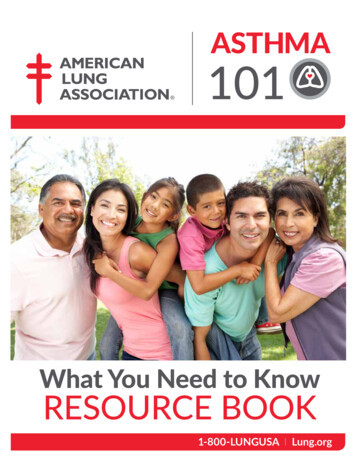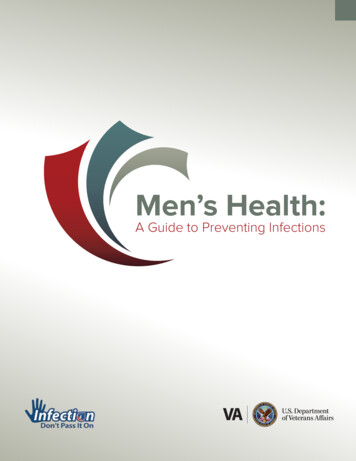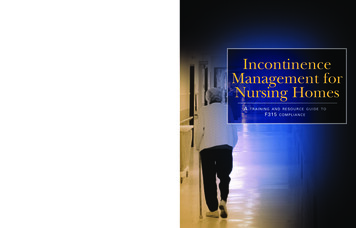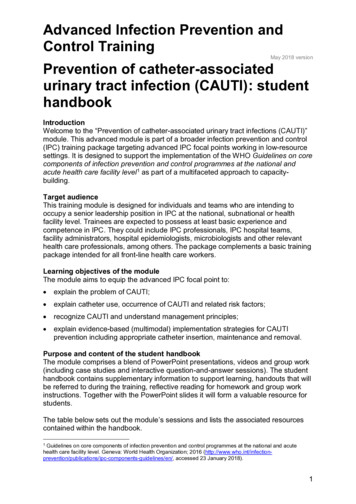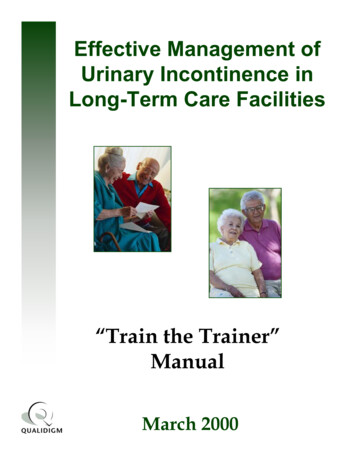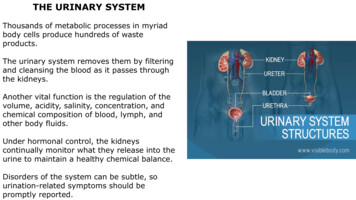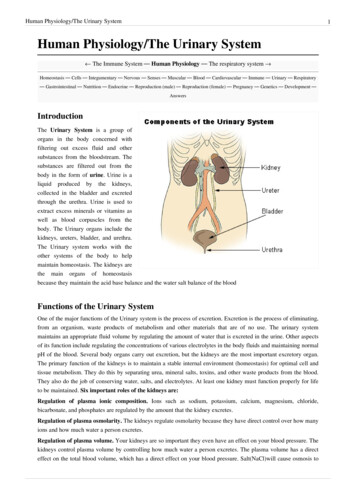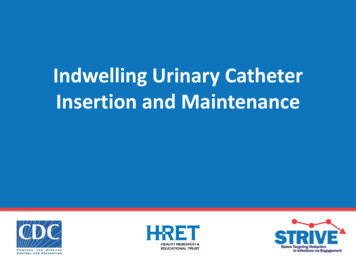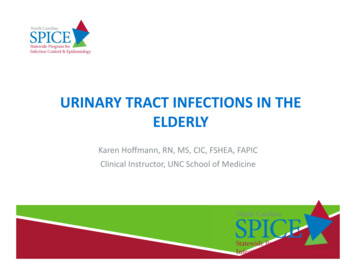
Transcription
URINARY TRACT INFECTIONS IN THEELDERLYKaren Hoffmann, RN, MS, CIC, FSHEA, FAPICClinical Instructor, UNC School of Medicine
DISCLAIMER The views and opinions expressed in this lectureare those of this speaker and do not reflect theofficial policy or position of any agency of the U.S.government
OBJECTIVES Differentiate between asymptomatic bacteruria and UTI Understand risks associated with use of Indwelling Urinary(foley) catheters Learn geriatric “pearls” in identifying, preventing andtreating UTIs in elderly Review antibiotic treatment guidelines for UTIs in elderly Discuss techniques in preventing both complicated anduncomplicated UTIs in elderly
UTI EPIDEMIOLOGY IN NURSING HOMES Primary cause of bacteremia in LTC residents is due to UTIs Incidence of symptomatic UTIs in elderly in LTC around10% Prevalence of asymptomatic bacteriuria in women approx.30% and 10% in men. Public reporting of catheter use rates in nursing homesover the past 15 years has driven down catheter usemarkedly.Why so common?
PHYSIOLOGIC RISK FACTORS FORUTIS IN THE ELDERLY (1)Physiologic changes of bladder with aging:Women: Elevation of vaginal pH due to estrogen deficiency results in increased ability of bacteria to adhere to the mucosalcells of the bladder.Men: Decreased bactericidal activity of prostatic secretionsIncreased post‐void residual volume of urine‐ Cystocele/rectocele‐ Prostate hypertrophy‐ Neurogenic bladder from comorbidity
ENVIRONMENTAL RISK FACTORS FORUTI IN THE ELDERLYEnvironmental Risk Factors Indwelling urinary catheters Congregate living Mechanical/chemical restraints Increased exposure to antibiotics Poor infection control techniquesThe more impaired or frail the greater the risk of UTI!
PHYSIOLOGIC RISK FACTORS FORUTIS IN THE ELDERLY (2)Functional / Cognitive Impairment Decrease self care Decrease cues to void Increased incontinence and perineal soiling Difficulty finding bathroom / suitable location to void
RISK FACTORS FOR CAUTI Urinary stasis‐ below the bladder drainage Over‐distention – kinks Urethral trauma – catheter tug Improper handling of urine collection bag Duration of catheter use – biofilm buildup 5% risk per day of catherization, 30 days universalasymptomatic bactauria
CDC NHSN UTI DEFINITIONS Urinary Tract Infection (UTI) aka Acute UncomplicatedCystitis – infection of the bladder (lower urinary tract). Pyelonephritis – infection of the upper urinary tract(ureters / renal collecting system / kidneys). “Mixed flora” is not considered an organism and cannotbe reported. Yeast cannot be reported as an organism for a UTI. Urineculture with yeast can be included only if there is at leastone qualifying bacterium.
CMS MDS UTI CODING CRITERIAREVISED OCTOBER 2017 Item I2300 Urinary tract infection (UTI): The UTI has a look‐back period of 30 days for active diseaseinstead of 7 days. Code only if both of the following are met in the last 30 days: It was determined that the resident had a UTI using evidence‐based criteria such as McGeer, NHSN, or Loeb in the last 30days, AND A physician documented UTI diagnosis (or by a nursepractitioner, physician assistant, or clinical nurse specialist ifallowable under state licensure laws) in the last 30 eQualityInits/NHQIMDS30TechnicalInformation.html
DIAGNOSTIC DILEMMAS FOROLDER ADULTS WITH UTI Many of the common symptoms (urgency, frequency,incontinence, confusion, falls) occur frequently in thisage group. Atypical presenting symptoms may be heraldinganother illness. Older adults often have a blunted febrile response. Difficulty in obtaining a good history.
EVALUATION OF POSSIBLE UTI Vital signs are essential! Fever is the key in decision to treat! History and examination to rule out other causes ofatypical symptoms. U/A and C&S BEFORE starting antibiotics Clean catch vs I&O catheterization."Pyuria2011" by James Heilman, MD ‐ Own work. Licensed under CC BY‐SA 3.0 via Wikimedia Commons 11.JPG#mediaviewer/File:Pyuria2011.JPG
DIPSTICK URINALYSIS Leukocyte esterase positive (pyuria) Nitrites: positive (bacteriuria) Protein: small amount may be present Blood: small amount may be presentLeukocyte positive: 50–75%specific; 80‐90% sensitivePyuria alone not an indication fortreatment.
HEMATURIA Not common with UTIs in older adults. Frank hematuria should be evaluated promptly! Causes includes stones, cancer, trauma, infection andhemorrhage.
MICROBIOLOGY OF UTI 80% are caused by gram negative bacilli‐ E.coli, Klebsiella, Enterobacter, Proteus, and Serratia‐ Gram positive bacilli ‐ Staphylococcus
INDWELLING CATHETER‐ASSOCIATED UTI(CAUTI) Catheter colonization and infection is inevitable andexpected! Once bacteria colonizes urine, concentration is 100,000colonies within 72 hours!!
MECHANISMS OF COLONIZATION Colonic and perineal flora primary source Extra‐luminal‐‐ women – shorter urethra Manipulation of the collection system From hands of personnel during insertion Ascending from drainage bag/junction
HOW COLONIZATION OCCURS Microbes produce Biofilm on the catheter surface Biofilm is a defense strategy for microbes Protects microbes from body’s defenses andantimicrobials!
SPECIMEN COLLECTIONCDC recommends: Obtain urine samples aseptically. (Category IB) If a small volume of fresh urine is needed for examination (i.e.,urinalysis or culture), aspirate the urine from the needlelesssampling port with a sterile syringe/cannula adapter aftercleansing the port with a disinfectant. (Category IB) Obtain large volumes of urine for special analyses (not culture)aseptically from the drainage bag. (Category IB) https://www.cdc.gov/hicpac/cauti/02 cauti2009 abbrev.html
URINE CULTURE Gold STANDARD to guide appropriate treatment Results : 100,000 colonies of one species Treatment can be delayed until cultures results available. Positive culture (bacteriuria) alone not a reason to treat.
TREATMENT /NO TREATMENT Asymptomatic bacteriuria should NOT be treated. Routine or post‐treatment screening for bacteriuria is notrecommended. (Infectious Diseases Society of America No benefits in decreasing rates of subsequent UTIs Increased risk of resistance and uropathogens
CMS UTI ANTIBIOTIC TREATMENTCMS DNH §483.25(e)(2)(i)Minimum criteria for initiating antibiotics for an indication of urinary tract infectionwere considered for residents with no indwelling urinary catheters and for residentswith chronic indwelling catheters.1. NO indwelling catheter, include: acute dysuria alone or fever ( 37.9ºC [100ºF] or1.5ºC [2.4ºF] increase above baseline temperature) and at least one of the following: new or worsening urgency, frequency, suprapubic pain, gross hematuria,costovertebral angle tenderness, or urinary incontinence.2. Chronic indwelling catheter (indwelling Foley catheter or a suprapubic catheter),includes the presence of at least one of the following: fever ( 37.9ºC [100ºF] or 1.5ºC [2.4ºF] increase above baseline temperature), new costovertebral tenderness, rigors (shaking chills) with or without identifiedcause, or new onset of delirium.”Reference ‐ “Development of Minimum Criteria for the Initiation of Antibiotics in Residents of Long‐Term–Care Facilities:Results of a Consensus Conference” ‐ Infect Control Hosp Epidemiol 2001;22:120‐124.
REGULATION: F 690 (FORMERLY F315) §483.25(d) Urinary Incontinence Based on the resident’s comprehensive assessment, the facilitymust ensure that - §483.25(d) (1) A resident who enters the facility without anindwelling catheter is not catheterized unless the resident’sclinical condition demonstrates that catheterization wasnecessary; and §483.25(d) (2) A resident who is incontinent of bladderreceives appropriate treatment and services to prevent urinarytract infections and to restore as much normal bladderfunction as possible.
INTERMITTENT CATHETERIZATION IIntermittent catheterization can often manage overflowincontinence effectively. New onset incontinence from a transient,hypotonic/atonic bladder (usually seen followingindwelling catheterization in the hospital) may benefitfrom intermittent bladder catheterization until the bladdertone returns (e.g., up to approximately 7 days). A voiding trial and post void residual can help identifywhen bladder tone has returned.overflow incontinence effectively
APPROPRIATE USE OF URINARYCATHETERS Clinical criteria for long/short for indwelling catheter: Obstruction Neurogenic bladder Hematuria (short term) Surgery (short term) Wounds stage 3 or Aggressive diuresis / monitoring of strict I/O (short term) Terminally ill for comfort measures Develop policies for independent nursing removal andeducation on technique for placement and management ofdevice and collecting bag CDC HICPAC Guidelines for Prevention of Catheter‐Assciated Urinary Tract Infections, 2009.
INAPPROPRIATE USE OF URINARY CATHETERS Used for the convenience of nursing staff. Used in lieu of other bladder management strategies. Used for specimen collection when the resident canvoluntarily void Catheter left in place when removal is indicated.(Indwelling catheters are associated with a 5% risk/day)CDCC HICPAC Guidelines for Prevention of Catheter Associated Urinary Tract Infections 2009
PREVENTION OF UTIS Hand Hygiene – both residents and staff Adequate hydration – 30cc/kg of body weight/day Perineal hygiene after toileting Routine toileting Removing urinary catheter as early as possible.
ROUTES OF ENTRY OF UROPATHOGENS TOCATHETERIZED URINARY TRACTSource: Maki and Tambyah (2001)
PREVENTION CATHETER‐ASSOCIATED UTI (1) Catheter used for appropriate indications. Urinary catheter duration of use minimized.Increase of 5% risk per day! Hand hygiene before and after insertion of catheter andduring any manipulation. Only properly trained persons for insertion using aseptictechnique.CDC HICPAC Guidelines for Prevention of Catheter Associated Urinary Tract Infections 2009
PREVENTION OF CATHETER‐ASSOCIATED UTI (2)CDC HICPAC GUIDELINES FOR PREVENTION OF CATHETER ASSOCIATED URINARY TRACTINFECTIONS 2009 Catheter properly secured to prevent urethral traction. Closed drainage system maintained. Unobstructed urine flow maintained. Collecting bag emptied regularly; using a separate cleancollecting container for each resident.
PREVENTION OF CATHETER‐ASSOCIATED UTI(3)CDC HICPAC GUIDELINES FOR PREVENTION OF CATHETER ASSOCIATED URINARY TRACT INFECTIONS 2009 Clean technique for intermittent catheterization. Standard Precautions during catheter manipulation. Periurethral cleaning with antiseptics notrecommended. Routine hygiene recommended. Routine use of antimicrobial/antiseptic‐impregnatedcatheters not recommended.
PREVENTION OF CATHETER‐ASSOCIATED UTI(4)CDC HICPAC GUIDELINES FOR PREVENTION OF CATHETER ASSOCIATED URINARY TRACT INFECTIONS 2009 No routine schedule for catheter replacement (e.g.monthly) If obstruction occurs ‐ change the catheter. Urine samples obtained aseptically.Note: Before urine samples for culture are obtained fromresident with a catheter in place 14 days, catheter shouldbe replaced and specimen obtained from new catheter.
PREVENTION OF CATHETER‐ASSOCIATED UTI(5)CDC HICPAC GUIDELINES FOR PREVENTION OF CATHETER ASSOCIATED URINARY TRACT INFECTIONS 2009 Quality Improvement Programs – based on facility riskassessment. QI Program should: assure utilization, daily need review,adherence to hand hygiene, care of catheters.‐ system of reminders of residents with catheters‐ guidelines and protocols for nurse‐directed removal ofunnecessary catheters.‐ Education and performance feedback of staff. Administrative Infrastructure – use of evidence basedguidelines, monitoring adherence, and education and training,ensuring supplies available and surveillance resources.
PROPHYLAXIS FOR UTI PREVENTION Cranberry juice/extract – currently not enoughevidence to recommend for or against use. Cochraneguidelines found no strong evidence forrecommending use in prophylaxis (2012). Oral Estrogens not shown to be beneficial. Topical, vaginally applied estrogens have beenshown to be effective in smaller studies (samplewas post‐menopausal).
STUDY FINDS LITTLE CONSISTENCY FOR UTIPREVENTION IN NURSING HOMES (1)Center for Health Policy at Columbia University School of Nursingsurveyed nursing homes across the U.S. in 2014.955 nursing homes with 88,135 residents were linked to CMSinfection data. 5.4% of 4,700 nursing home residents‐suffered a UTI everymonth. Residents with a catheter were 4X more likely to get a UTI thanno catheter. However, more infections were not associated with catheteruse than those that were.Ref. Stone P. et al. Presented at the APIC Annual Educational Conference, Charlotte,NC. 2016.5. 5.4 percent‐or more than 4,700 nursing home residents‐suffered from a UTI everymonth4 percent‐or more than 4ents‐suffered from a UTI every month
STUDY FINDS LITTLE CONSISTENCY FOR UTIPREVENTION IN NURSING HOMES (2)Examined 9 UTI prevention policies and found the following nursinghomes policies were associated with lower infection prevalence:Policy for portable bladder ultrasound scanners were 10% lesslikely to have high rates of UTIs that were not associated withcatheter use. Only 22% of surveyed facilities had this policy. Policy for cleaning the urine collection bag attached to theresident's leg were 20% less likely to have high rates of catheterassociated UTIs. Only 44% of surveyed facilities had this policy.If Infection preventionist (IP) on staff who took a national coursethrough APIC were 20% less likely to have high rates of UTIs.Only 9% of respondents had taken an APIC training course.Ref. Stone et al.
AGENCY FOR HEALTHCARE RESEARCH AND QUALITY(AHRQ) UTI PREVENTION PROJECT (1) Toolkit to help staff understand — and effectively and consistentlyuse — proven infection‐prevention practices and usage bestpractices. Results: CAUTIS fell 54% in 404 nursing homes in 38 states;6.4 to 3.33 CAUTIs per 1,000 catheter‐days. 75% of nursing homes had 40% decrease — even as usage ratesheld steady (about 4.5 percent of patients in the nursing homesused catheters); Number of lab tests clinicians ordered to check patients forinfections decreased 15%.Lona Mody, MD, MSc., JAMA Internal Medicine
AGENCY FOR HEALTHCARE RESEARCH AND QUALITY(AHRQ) UTI PREVENTION PROJECT(2) Monthly content training and coaching calls by project team.Behavior staff training for catheter indications, cathetermaintenance, laboratory testing indications, antibiotics,communication strategies. Urine lab cultures were performed 3.52 times for every 1,000patient days at the start of the project but went down to 3.09per 1,000 ‐ preventing false‐positives. Instead of relying on urine culture results, staff receivededucation to help them recognize the early symptoms of a UTI,including in people with dementia who cannot alwayscommunicate that they are experiencing pain or burning duringurination.
UNC UTI PREVENTION VIDEO From the Nursing Home Infection Prevention Courses byThe University of North Carolina at Chapel Hill develop bySPICE. Infection Prevention in Nursing Homes Video for stafftraining. rsing‐homes‐introduction
SUMMARY OF UTI/CAUTI Prevent Infection – unnecessary catheters removed(early on)! Colonization (the positive culture) should NOT betreated. Pyuria alone is not enough to make diagnosis of UTI Antibiotics should not be used to treat asymptomaticUTIs in LTCFs. Do not culture after completing antibiotic course.
REFERENCESHooton, TM; Calderwood, SB; Baron, E (2011) Acute Uncomplicated cycstitis,pyelonephritis, and asymptomatic bacteriuria in men. UpToDate. Accessed onlineJanuary, 2012Hooton, TM; Bradley, SF; Cardenas, DD; Colgan, R; Geerlings, SE; Rice, JE; Saint, S;Schaeffer, AJ; Tambayh, PA; Nicolle, LE (2010) Diagnosis, prevention, andtreatment of of catheter associated urinary tract infection in adults: 2009international clinical practice guidelines from the infectious disease society ofamerica. Clinical Practice Guidelines. 2010: 50 MarchMathews, JS; Lancaster, JW (2011) Urinary tract infection in the elderly population.The American Journal of Geriatric Pharmacotherapy. 9 (5) p. 286‐309McMurdo, ME; Argo, I; Phillips, G; Daly, F; Davey P. (2009) Cranberry ortrimethoprim for the prevention of recurrent urinary tract infections? Arandomized controlled trial in older women. Journal of AntimicrobialChemotherapy 63, p 389‐395Mouton, C; Adenuga, B; Vijayan, J (2010). Urinary tract infections in long‐term care.Annals of Long‐Term Care 18 (2) p. 35‐39.
REFERENCESCohen, KR; Frank, J; Israel, I (2011). UTIS in the geriatric population:chanllenges for clinicians. US Pharmacist. 36 (6) p. 46‐54Family CareGiver Alliance: National Center on Caregiving. (2012). Fact Sheet:Selected Long‐Term Care Statistics.Fekete,T ; Calderwood, SB; Baron, E (2011) Urinary tract infection associatedwith urethral catheters. UpToDate. Accessed online January, 2012Garner, JS; Jarvis, WR, Emori, TG, et al (1988) CDC Definitions of NosocomialInfections. Journal of Infection Control, 16. p 128‐140Gupta, K; Hooton, TM; Naber, KG; Wult, B; Colgan, R; Miller, LG; Moran, GJ;Nicolle, LE; Raz, R; Schaeffer, AJ; Soper, DE (2011). International clinicalpractice guidelines for the treatment of acute uncomplicated cystitis andpyelonephritis in women: a 2010 update by the infectious disease societyof america and the european society for microbiology and infectiousdisease. Clinical Practice Guidelines. 2011:52, March
PREVENTION OF UTIS Hand Hygiene -both residents and staff Adequate hydration - 30cc/kg of body weight/day Perineal hygiene after toileting Routine toileting Removing urinary catheter as early as possible. ROUTES OF ENTRY OF UROPATHOGENS TO CATHETERIZED URINARY TRACT Source: Maki and Tambyah (2001) PREVENTION CATHETER‐ASSOCIATED UTI (1)

